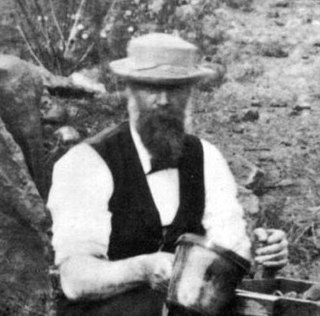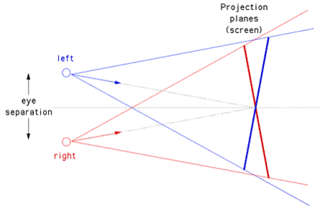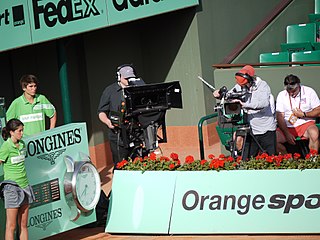
Sir David BrewsterKH PRSE FRS FSA Scot FSSA MICE was a Scottish scientist, inventor, author, and academic administrator. In science he is principally remembered for his experimental work in physical optics, mostly concerned with the study of the polarization of light and including the discovery of Brewster's angle. He studied the birefringence of crystals under compression and discovered photoelasticity, thereby creating the field of optical mineralogy. For this work, William Whewell dubbed him the "father of modern experimental optics" and "the Johannes Kepler of optics."

Stop motion is an animated filmmaking and special effects technique in which objects are physically manipulated in small increments between individually photographed frames so that they will appear to exhibit independent motion or change when the series of frames is played back. Any kind of object can thus be animated, but puppets with movable joints or plasticine figures are most commonly used. Puppets, models or clay figures built around an armature are used in model animation. Stop motion with live actors is often referred to as pixilation. Stop motion of flat materials such as paper, fabrics or photographs is usually called cutout animation.

Sir Brian Harold May is an English musician, songwriter, record producer, animal welfare activist and astrophysicist. He achieved worldwide fame as the lead guitarist and backing vocalist of the rock band Queen, which he co-founded with singer Freddie Mercury and drummer Roger Taylor. His guitar work and songwriting contributions helped Queen become one of the most successful acts in music history.

Stereoscopy is a technique for creating or enhancing the illusion of depth in an image by means of stereopsis for binocular vision. The word stereoscopy derives from Greek στερεός (stereos) 'firm, solid' and σκοπέω (skopeō) 'to look, to see'. Any stereoscopic image is called a stereogram. Originally, stereogram referred to a pair of stereo images which could be viewed using a stereoscope.
3D films are motion pictures made to give an illusion of three-dimensional solidity, usually with the help of special glasses worn by viewers. They have existed in some form since 1915, but had been largely relegated to a niche in the motion picture industry because of the costly hardware and processes required to produce and display a 3D film, and the lack of a standardized format for all segments of the entertainment business. Nonetheless, 3D films were prominently featured in the 1950s in American cinema, and later experienced a worldwide resurgence in the 1980s and 1990s driven by IMAX high-end theaters and Disney-themed venues. 3D films became increasingly successful throughout the 2000s, peaking with the success of 3D presentations of Avatar in December 2009, after which 3D films again decreased in popularity. Certain directors have also taken more experimental approaches to 3D filmmaking, most notably celebrated auteur Jean-Luc Godard in his film Goodbye to Language.

A stereoscope is a device for viewing a stereoscopic pair of separate images, depicting left-eye and right-eye views of the same scene, as a single three-dimensional image.

Carleton E. Watkins (1829–1916) was an American photographer of the 19th century. Born in New York, he moved to California and quickly became interested in photography. He focused mainly on landscape photography, and Yosemite Valley was a favorite subject of his. His photographs of the valley significantly influenced the United States Congress' decision to preserve it as a National Park.
A random-dot stereogram (RDS) is stereo pair of images of random dots that, when viewed with the aid of a stereoscope, or with the eyes focused on a point in front of or behind the images, produces a sensation of depth due to stereopsis, with objects appearing to be in front of or behind the display level.
Stereopsis is the component of depth perception retrieved through binocular vision. Stereopsis is not the only contributor to depth perception, but it is a major one. Binocular vision happens because each eye receives a different image because they are in slightly different positions in one's head. These positional differences are referred to as "horizontal disparities" or, more generally, "binocular disparities". Disparities are processed in the visual cortex of the brain to yield depth perception. While binocular disparities are naturally present when viewing a real three-dimensional scene with two eyes, they can also be simulated by artificially presenting two different images separately to each eye using a method called stereoscopy. The perception of depth in such cases is also referred to as "stereoscopic depth".

The history of photography began with the discovery of two critical principles: The first is camera obscura image projection; the second is the discovery that some substances are visibly altered by exposure to light. There are no artifacts or descriptions that indicate any attempt to capture images with light sensitive materials prior to the 18th century.

Precursors of film are concepts and devices that have much in common with the later art and techniques of cinema.
The Keystone View Company was a major distributor of stereographic images, and was located in Meadville, Pennsylvania. From 1892 through 1963 Keystone produced and distributed both educational and comic/sentimental stereoviews, and stereoscopes. By 1905 it was the world's largest stereographic company. In 1963 Department A and the Education Departments were closed down, but Keystone continued to manufacture eye-training stereographic products as a subsidiary of Mast Development Company. In 1972 Mast closed the Meadville manufacturing site.
Thomas Richard Williams was a British professional photographer and one of the pioneers of stereoscopy.

A 3D stereo view is the viewing of objects through any stereo pattern.

Hinton Waldrist is a village and civil parish in the Vale of White Horse, England. It was part of Berkshire until the 1974 boundary changes transferred it to Oxfordshire. The village is between Oxford and Faringdon, 9 miles (14 km) southwest of Oxford. The parish includes the hamlet of Duxford. The 2011 Census recorded the parish's population as 328.

The London Stereoscopic and Photographic Company was founded in 1854 by George Swan Nottage and Howard John Kennard. Known initially as the London Stereoscope Company, in 1856 it changed its name to the London Stereoscopic Company, then in May 1859, became the London Stereoscopic and Photographic Company. For most purposes, however, it was referred to as the London Stereoscopic Company (LSC).
Ethan Allen Russell is an American photographer, author and video director, mostly of musicians. He is known as "the only rock photographer to have shot album covers for The Beatles, The Rolling Stones and The Who."

Les Diableries is the title of a series of stereoscopic photographs published in Paris during the 1860s. The photographs, commonly known as stereoviews, portray sculpted clay vignettes which depict scenes of daily life in Hell. Much of the subject matter was satirical and mirrored the corruption and excess of Paris during the Second Empire. Napoleon III's authoritarian rule was repeatedly the subject of criticism, as was the decadent lifestyle of the bourgeoisie.

Stereo photography techniques are methods to produce stereoscopic images, videos and films. This is done with a variety of equipment including special built stereo cameras, single cameras with or without special attachments, and paired cameras. This involves traditional film cameras as well as, tape and modern digital cameras. A number of specialized techniques are employed to produce different kinds of stereo images.
Claude-Marie Ferrier (1811–1889) was an early French photographer, known for his portraits of prominent French people, his work at the London Great Exhibition, and for his production of stereoviews to be viewed through the stereoscope invented by David Brewster.












